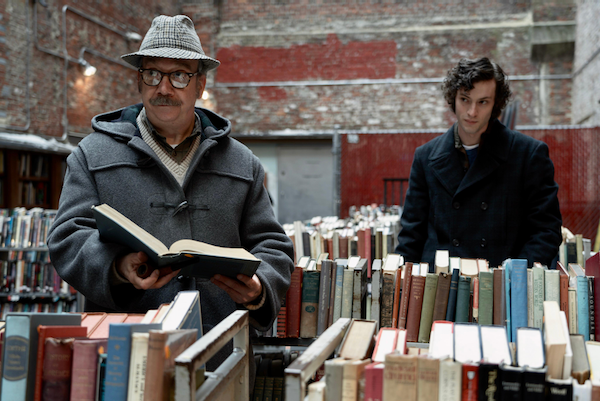Movie review by Greg Carlson
Focus Features gets a nifty opening credits layout as part of a throwback sequence capitalizing on the heavy New Hollywood nostalgia that suffuses Alexander Payne’s comic melodrama “The Holdovers.” Reuniting with “Sideways” star Paul Giamatti, Payne’s new movie is his first feature since the bizarre 2017 sci-fi misfire “Downsizing.” Closer in spirit to the more intimate emotional nakedness of “Nebraska,” “The Holdovers” lacks the lacerating satirical edges of debut “Citizen Ruth” and “Election” (my personal top pick of the director’s movies) in favor of a heartwarming, Christmas-themed (com)passion play. In another variation on the “grouch with a heart of gold” formula, Payne makes the most of Giamatti’s rapport with newcomer Dominic Sessa and a superb Da’Vine Joy Randolph.
In the winter of 1970-1971, Giamatti’s Paul Hunham teaches classical history to ungrateful, privileged boys at Barton Academy in New England. Paul’s fondness for tobacco pipe and whiskey glass steadies his nerves and masks the unfortunate odor caused by the trimethylaminuria that causes him to emanate a fishy reek. With no family and nowhere to go during break, he’s an easy mark to accept the thankless duty of looking after the small group of students who spend the holiday on campus. Soon enough, the number of holdovers dwindles to a single charge: the surly Angus Tully (Sessa), who can’t conceal his anger at being left behind while his mother and her new husband jet to sunnier climes.
Paul and Angus let fly all manner of colorful insult and withering put-down even as the requirements of basic civility at shared meals yoke them together. Randolph’s symbolically-monikered Mary Lamb, who runs Barton’s kitchen, also remains in residence. A longtime staff member grieving the death of her young adult son (and Barton grad), who died while serving in Vietnam, Mary mediates the animosity between the males. The threesome will eventually take a road trip and Payne, unfortunately, loses track of Mary for a long stretch once she is dropped off at her sister’s residence.
Randolph, who steals all her scenes, is sorely missed even if her absence allows the mechanics of the plot to bring Paul and Angus to a place of mutual respect and an understanding that they are a lot more alike than they are dissimilar. Payne, who was inspired by Marcel Pagnol’s 1935 “Merlusse,” cares less for the story beats than he does for the atmosphere and the vibes, which pay homage to everything from Wes Anderson’s “Rushmore” (which also used “The Wind” by Cat Stevens) to Anderson inspiration J. D. Salinger’s “The Catcher in the Rye.” In one scene, Paul disrupts a screening of “Little Big Man,” but Payne at least has the good sense to include a disgruntled patron who admonishes the interruption.
Some critics have griped about a perceived lack of sincerity in Payne’s delivery. Justin Chang, for example, wrote that the movie “seldom stops trying to convince you how sensitive it is, even as its mix of coyness and overstatement, its clunky tonal seesaws between humor and pathos, and its pride in its own good liberal conscience suggest that it hasn’t begun to think through its characters and their circumstances at all.” I don’t believe I saw the same film, since I would argue that the characters and their circumstances – Mary schooling Paul on the raison d’être of “The Newlywed Game,” a lonely mitten floating by, Angus discovering an unexpected romance during a Christmas party – are the finest aspects. In the margins, “The Holdovers” is a great hang.
